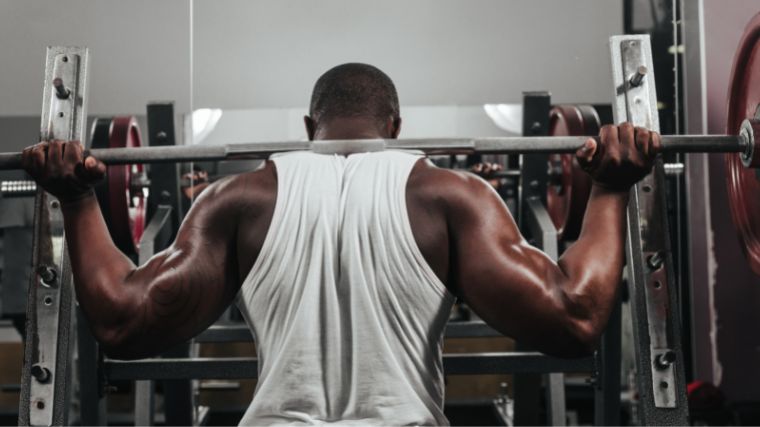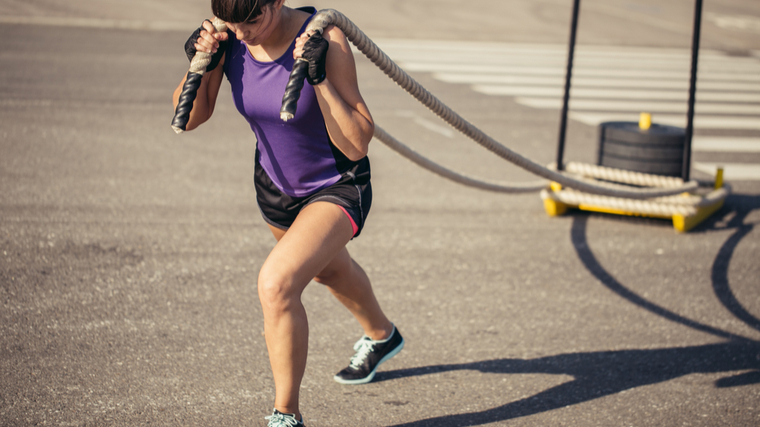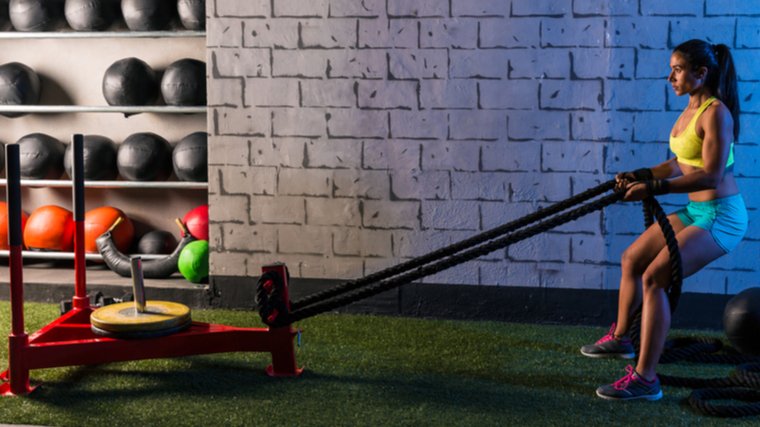Originally Posted At: https://breakingmuscle.com/feed/rss
If you’re going to the gym, you most likely want to be healthier. You also want to add muscle to your frame, set personal records, and perform better than you did the last workout. You’re driven, and you channel that drive into rigorous weekly training sessions. But being all go, go, go, will eventually bring your progress to a screeching halt. You need to train hard. You also need to know when to ease up.
Enter: Deload weeks.

By incorporating an intentional week of easier training into your routine, you can avoid overtraining, allow for more optimal recovery, and push your progress further than if you keep grinding away. It’s a strategy used by some of the best strength athletes on the planet. Here’s what you need to know.
Deload to Reload
- Deloads Explained
- How Deloads Work
- Who Should Deload
- When to Deload
- Will I Lose my Gains?
- Types of Deloads
- Sample Deload Programs
What is a Deload?
A deload is a temporary and intentional reduction of training stress to promote recovery. While illness, injury, and other unexpected events may force a lifter to dial back training or take time off from the gym, many healthy lifters can benefit from a deliberate deload.
Progressive overload is the key feature of effective training for size, strength, and athleticism. Without progressive overload, gains may slow or stall over time. (1)(2) This is called a “plateau.” Deloading can help lifters push past these plateaus for continued progress. Think about taking one step back to take two forward.
Incorporating deloads reduces the risk of inefficient training by allowing a short period of recovery, which can be followed by hard training with renewed vigor. Intermittent deloads might help you avoid injury and overtraining. In a culture that glorifies the “hardest workers in the room,” hustle porn, and #grinding, it is not trendy to talk about balanced training. However, if you are willing to exchange a temporary feeling of effort for renewed progress, deloads are for you.
How Deloads Work
To understand the mechanism of a deload, strength and conditioning professionals lean on two guiding paradigms: Bannister’s Fitness-Fatigue Model and Selye’s General Adaptation Syndrome.
Fitness-Fatigue Model
The Fitness-Fatigue Model describes competing aftereffects of training. Fitness encompasses the positive outcomes of training, including but not limited to increased muscle size, muscle protein adaptations, and enzyme concentrations. (2) Fatigue represents the neuromuscular effects that hurt our ability to perform.
The time frames of these aftereffects are not identical; fatigue tends to be relatively short-lived and fitness more persistent. (2) The difference between fitness and fatigue can be conceptualized as preparedness — your ability to handle another training stressor. Preparedness fluctuates throughout our training routines, typically peaking after periods of recovery and reaching its lowest point following repeated, strenuous workouts.
General Adaptation Syndrome
The General Adaptation Syndrome describes three stages of response to a stressor such as training: alarm, resistance, and exhaustion.

Immediately after a training session, the alarm stage occurs, which is characterized by reduced performance. In the resistance stage, performance returns to baseline or slightly higher, a phenomenon known as super-compensation. (2) The exhaustion stage occurs if training stress is too frequent, too long, or too intense, and results in impaired recovery, blunted fitness adaptations, and poor performance.
Putting It Together
The Fitness-Fatigue Model and the General Adaptation Syndrome help us to understand that load, volume, and frequency are essential training considerations. Rather than suffer more science, let’s use an analogy to explore how these paradigms relate to deloads.
In Greek mythology, Sisyphus was cursed by Zeus to roll a stone up a mountain for eternity. In this analogy, you’re Sisyphus, damned to toil in the underworld (“gym”). Think of the stone as your training status — the higher up the mountain the stone is, the better your fitness. Your task is to map a sustainable path up the mountain.
In our analogy, picking your route up the mountain is like programming workouts. If you stay on a path that is too steep for too long — if you hit challenging workouts day-after-day and week-after-week — fatigue will accumulate and the stone will back-slide down the mountain.
Here’s the good news — you can chart a path of switchbacks and detours to promote recovery. These gentle paths and valleys are deload periods, and they allow the stone to generate momentum. This momentum is your preparedness to train. With the stone rolling faster, you’re better able to push for the next summit successfully.
Who Should (and Shouldn’t) Deload
Owing to the super-compensation effect, a lifter should come off a well-executed deload ready to perform and look their best. Therefore, any lifter with deadline-based performance or aesthetic goals may wish to deload immediately beforehand to enjoy the fruits of their training. Suppose you don’t have a high-priority competition, photoshoot, or other event on the horizon. In that case, the decision of whether to deload comes down to training status and your current responses to training.
Beginners — Yay or Nay?
Anecdotally, beginner lifters with less than six to 12 months of consistent training do not typically need to deload. They have not built the strength and coordination required to tax their neuromuscular systems profoundly. If you are a new lifter, enjoy the honeymoon period of robust gains by simply tracking your lifts to ensure you’re achieving progressive overload.
Practically, a beginner’s progression may look like a five to 10 percent increase in weekly volume-load (sets x reps x weight) with gradual increases in weight for your primary exercises. Plan to deload as this period of robust progress slows — typically, six to 12 months in. Recognize that if you choose to deload as a beginner, you may appear to “lose” some size. However, this is primarily due to clearance of muscle swelling, which typically persists at least three days following hard training. (3)
Advanced Trainees
Intermediate and advanced lifters not currently following a well-designed training program will benefit most from a deload.

A well-designed program incorporates periods of reduced training stress, like intermittent reductions in load (weight), volume (sets x reps), and proximity to failure (repetitions in reserve, number of sets taken to failure or past failure).
These reductions may occur between training blocks or within training blocks. Even for lifters using a well-designed training program, a deload might still be helpful in certain circumstances, such as before a high-priority event or competition.
When to Deload
A typical deload lasts approximately one week. Leading up to a high-priority event, the lifter should deload the week prior. In the absence of a major event, programming deloads is more nuanced. Some coaches insist on planned deloads, which occur regularly (e.g., every four to 12 weeks). Others prefer reactive deloads, which describes the judicious use of deloads on an as-needed basis.
Life and training are not always predictable. Therefore, the reactive approach can help ensure deloads are programmed when recovery status is poor and it can allow hard training to continue when recovery status is strong. A variety of metrics can serve as indicators of recovery status. Technology-based methods of monitoring recovery status can be great but may require sophisticated equipment, tedious monitoring, and knowledge of exercise physiology for interpretation. Instead, you can keep track of essential training performance (sets, reps, weight) and subjective indicators, such as motivation to train, sleep quality, and fatigue.
A simple method for determining when to program a reactive deload is “one to five”. Take a one-week deload after noting one or more of the following:
- Two consecutive training sessions of reduced performance (e.g., unintentional drop in session volume-load).
- Three consecutive training sessions with poor motivation to train.
- Four consecutive nights of poor sleep quality or consecutive days of increased generalized fatigue.
- Five consecutive workouts with no ability to progress (e.g., stagnation of session volume-load).
Now that you know when it’s time to deload, let’s alleviate a common fear related to the process.
Will Deloads Ruin My Gains?
No.
Based on our understanding of the Fitness-Fatigue Model and General Adaptation Syndrome, periodic deloads ensure meaningful progress. However, many lifters still worry about losing size and strength from a deload.
You won’t lose your gains. The typical deload lasts approximately one week. Research suggests it takes much longer to de-train.
Following eight days of abstinence from training, intermediate and advanced lifers do not lose muscle size. (4) In fact, trained lifters who take time off do not lose significant muscle size for at least three weeks and may experience an accelerated period of growth upon their return. (5) Strength may slip away slightly faster than size, with reductions reported after two to four weeks away from training. (6)(7) Remember that a deload does not necessarily mean time off.
Types of Deloads
Deloads can be structured in many ways. At the core of each protocol is a reduction in volume, load, and/or the proximity sets are taken to failure. Select a deload protocol based on your goals and preferences.
Traditional Deload
Best for: Planned or reactive deloads for the “set it and forget it”-type of trainee.
What it is: The Traditional Deload is straightforward. It reduces volume aggressively and decreases load modestly to leave you feeling fresh. It is appropriate for many lifters with goals ranging from strength to hypertrophy.
How to Do it: Cut the number of sets you typically perform by 50%. Cut the load you lift for each exercise by 20%.
Autoregulated Deload
Best for: Planned or reactive deloads for lifters with strength-, size-, and athletic-oriented goals.
What it is: The Autoregulated Deload works particularly well for strength athletes because they can continue to lift heavy while ensuring coordination and technique are maintained throughout the deload. A prerequisite is a willingness and ability to gauge your level of effort by estimating repetitions to failure or repetitions in reserve (RIR).
This model uses RIR to more precisely determine how many repetitions you should perform in each set. By doing so, we individualize the number of repetitions performed per set. The final repetitions leading to failure in each set are the most physical and neurologically taxing; this method eliminates those repetitions while allowing progressively more repetition volume as your recovery status improves.
How to Do it: First, reduce the number of sets you planned to perform (or usually perform) by 50%. For any sets you’d perform with fewer than five repetitions, perform one single rep at the weight you’d typically perform four repetitions with (e.g., one rep at approx. 90% 1RM). For all other sets, forget about your repetition target.
You will perform each of your sets until the point you feel you have four RIR or four reps left in the tank. Advanced trainees have been shown to accurately predict when they have four RIR within ±1 repetition. (8) General population trainees typically estimate with similar accuracy. (9) So, don’t worry about your accuracy; you’re more accurate at estimating repetitions to failure than you think.
Physique Deload
Best for: Planned deloads for aesthetics; planned or reactive deloads for those with hypertrophy goals; reactive deloads for lifters with sore joints.
What it is: The Physique Deload is modeled after peak week practices of bodybuilders. (10)(11) High-volume, moderate-load lifting is maintained at the beginning of the week to deplete stored energy in muscle called glycogen. Then, training is drastically cut to allow for super-compensation and maximization of glycogen content. Since muscle glycogen carries plenty of water, the result is bigger and fuller muscles. The final four days of the week are taken “off”. Rest assured, the volume load you completed early in the week will carry you through the deload.
How to Do it: For the first three days of the deload, training should be maintained or shifted to moderate weight (e.g., 65-80% of your one-rep max) and moderate-to-high repetition volume to ensure sets approach failure (e.g., eight to 14-plus repetitions). Don’t lift the final four days of the deload. During this time, you can perform light cardio and stretch.
Progressive Taper Deload
Best for: Planned deload for event performance. Dedicated lifters should enjoy friendly competition.
What it is: This deload will ensure your resistance training will not interfere with your ability to dominate your local 5k, obstacle course relay, or stand-up paddleboard race. This taper is shorter and less complicated than a typical pre-meet powerlifting taper, but it incorporates the same principles — maintain a high intensity and aggressively cut volume. (12) It is also applicable for athletes preparing for strength events or leading up to a one-repetition maximum (1RM) or multiple max rep attempts.
How to Do it: Maintain planned or typical load. Reduce set volume in a step-wise fashion. On days one through three, cut sets by 50%. On days four through six, cut sets by 75%, and rest on day seven.
Deload Examples
To be effective, the deload program must be individualized to your current training status and program design. This section uses general, isolated workout examples to illustrate how to use the deloads discussed above. Per the descriptions above, planned or usual programming modifications should be conducted throughout the week.
Note: Any exercise marked with the same letter is to be performed as a superset, meaning the movements are done back-to-back with no rest between movements.
Traditional Deload Example
| Exercise | Usual Program (sets x reps) | Usual Weight | Deload Program (sets x reps)* | Deload Program Weight** |
| A1: Bench Press | 4 x 8 | 78.5% 1RM | 2 x 8 | 80% of 78.5%1RM 1RM load |
| B1: Seated Overhead Press | 3 x 10 | 75% 1RM | 1 x 10 | 80% of 75% 1RM load |
| B2: Dumbbell Pec Flye | 3 x 12 | 45 lb ≈ 20 kg | 1 x 12 | 35 lb ≈ 15 kg |
| C1: Weighted Dip | 4 x 10 | 75 lb ≈ 30 kg | 2 x 10 | 60 lb ≈ 27 kg |
| D1: Lateral Raise | 5 x 15 | 20 lb ≈ 9 kg | 3 x 15 | 15 lb ≈ 7 kg |
| D2: Overhead Triceps Extension | 5 x 10 | 90 lb ≈ 40 kg | 3 x 10 | 70 lb ≈ 30 kg |
*Reduce the number of sets by ≈50% **Reduce load by ≈20%
Autoregulatory Deload Example
| Exercise | Usual Program (sets x reps) | Usual Weight | Deload Program (sets x reps)* | Deload Program Weight*** |
| A1: Front Squat | 5 x 5 | 85% 1RM | 2x(**) at 4RIR | 85%1RM |
| B1: Romanian Deadlift | 3 x 8 | 72.5% 1RM | 2x(**) at 4RIR | 72.5% 1RM |
| C1: Hamstring Curl | 4 x 12 | 70 lb ≈ 32 kg | 2x(**) at 4RIR | 70 lb ≈ 32 kg |
| C2: Leg Extension | 4 x 15 | 135 lb ≈ 60 kg | 2x(**) at 4RIR | 135 lb ≈ 60 kg |
| D1: Seated Calf Raise | 4 x 15 | 270 lb ≈ 120 kg | 2x(**) at 4RIR | 270 lb ≈ 120 kg |
| D2: Lateral Lunge | 4 x 10 | 135 lb ≈ 60 kg | 2x(**) at 4RIR | 135 lb ≈ 60 kg |
*Reduce the number of sets by ≈50%
**Sets are performed until 4 Repetitions in Reserve (RIR)
***Load is maintained for the Autoregulatory Deload
Physique Deload Example
| Exercise | Usual Program (sets x reps) | Usual Weight | Deload Program (sets x reps)* | Deload Program Weight*** |
| A1: Lat Pulldown | 3 x 12 | 70% 1RM | 3 x 12 | 70%1RM |
| A2: Bench Press | 3 x 8 | 75% 1RM | 3 x 8 | 75% 1RM |
| C1: Barbell Bent-Over Row | 4 x 4 | 85% 1RM | 4 x 12 | 65% 1RM |
| D1: Incline Bench Press | 4 x 4 | 88% 1RM | 4 x 12 | 70%1RM |
| D2: Reverse Flye | 4 x 15 | 25 lb ≈ 11 kg | 4 x15 | 25 lb ≈ 11 kg |
| E1: Skull Crusher | 4 x 12 | 85 lb ≈ 38 kg | 4 x 12 | 85 lb ≈ 38 kg |
| E2: Hammer Curl | 4 x 12 | 40 lb ≈ 18 kg | 4 x1 2 | 40 lb ≈ 18 kg |
*Maintain set volume. Shift repetition volume to moderate or moderate-high (8-14+ reps)
**Shift load according to set volume to facilitate sets approaching failure. Notes: Some exercises from Planned or Usual may not require modification if already within range. No lifting the final four days of the Physique Deload week.
Progressive Taper Deload
| Exercise | Usual Program (sets x reps) | Usual Weight | Deload Program (sets x reps)* | Deload Program Weight*** |
| A1: Push Press | 4 x 3 | 70% 1RM | 1 x 3 | 70%1RM |
| B1: Deadlift | 3 x 4 | 88% 1RM | 1 x 4 | 88% 1RM |
| C1: Landmine Row | 4 x 10 | 75% 1RM | 4 x 10 | 75% 1RM |
| C2: Decline Bench Press | 4 x 8 | 80% 1RM | 1 x 8 | 80% 1RM |
| D1: Goblet Squat | 3 x 12,10,8 | 90 lb ≈ 40 kg | 1 x 12 | 90 lb ≈ 40 kg |
| D2: Pull-Up | 4 x 10,8,6,5 | Bodyweight | 1 x 10 | Bodyweight |
*Reduce set volume by 50% for the first three days. Reduce by 75% for days four to six. Rest Day 7.
**Planned or usual load is maintained for the Progressive Taper Deload.
Wrapping Up
As training and life stressors accumulate, fatigue begins to overshadow fitness. The solution is a deload —a light week of training that promotes recovery. Deloads are not fun, sexy, or impressive. We deload for the super-compensation effect and increased preparedness to train. If you’ve deloaded for an event, enjoy the opportunity to express your fitness or savor the feeling of achieving your best physique.
If you’ve completed a deload to prepare for the next training cycle, be sure to re-test your strength. Use this information to re-calibrate your training loads and percentages going forward. Just as Sisyphus tirelessly pushes his stone, the smart lifter must constantly seek ways to optimize training. Fortunately, the path to effective training is simple: deload, reload, overload, and repeat.
References
- Lambrianides, Y., Epro, G., Smith, K., et al. (2022). Impact of Different Mechanical and Metabolic Stimuli on the Temporal Dynamics of Muscle Strength Adaptation. The Journal of Strength & Conditioning Research, e-pub ahead of print. doi: 10.1519/JSC.0000000000004300.
- Chiu, L. Z., Barnes, J. L. (2003). The fitness-fatigue model revisited: Implications for planning short-and long-term training. Strength & Conditioning Journal, 25(6), 42-51.
- Damas, F., Phillips, S. M., Lixandrão, M. E., et al. (2016). Early resistance training-induced increases in muscle cross-sectional area are concomitant with edema-induced muscle swelling. European Journal of Applied Physiology, 116(1), 49-56.
- Haun, C. T., Vann, C. G., Osburn, S. C., et al. (2019). Muscle fiber hypertrophy in response to 6 weeks of high-volume resistance training in trained young men is largely attributed to sarcoplasmic hypertrophy. PLoS One, 14(6), e0215267.
- Fisher, J., Steele, J., & Smith, D. (2013). Evidence-based resistance training recommendations for muscular hypertrophy. Medicina Sportiva, 17(4), 217-234.
- Joo, C. H. (2018). The effects of short term detraining and retraining on physical fitness in elite soccer players. PloS One, 13(5), e0196212.
- Sousa, A. C., Marinho, D. A., Gil, M. H., et al. (2018). Concurrent training followed by detraining: does the resistance training intensity matter?. The Journal of Strength & Conditioning Research, 32(3), 632-642.
- Odgers, J. B., Zourdos, M. C., Helms, E. R., et al. (2021). Rating of perceived exertion and velocity relationships among trained males and females in the front squat and hexagonal bar deadlift. The Journal of Strength & Conditioning Research, 35, S23-S30.
- Hackett, D. A., Cobley, S. P., Davies, T. B., et al. (2017). Accuracy in estimating repetitions to failure during resistance exercise. The Journal of Strength & Conditioning Research, 31(8), 2162-2168.
- Escalante, G., Stevenson, S. W., Barakat, C., et al. (2021). Peak week recommendations for bodybuilders: An evidence-based approach. BMC Sports Science, Medicine and Rehabilitation, 13(1), 1-24.
- Alves, R. C., Prestes, J., Enes, A., et al. (2020). Training programs designed for muscle hypertrophy in bodybuilders: a narrative review. Sports, 8(11), 149.
- Grgic, J., Mikulic, P. (2017). Tapering practices of Croatian open-class powerlifting champions. The Journal of Strength & Conditioning Research, 31(9), 2371-2378.
Featured Image: paul prescott / Shutterstock
The post The Science Behind Deload Weeks Explained appeared first on Breaking Muscle.










 For now classes are 6pm and 640pm at 2840 Wildwood st in the Boise Cloggers studio.
Book your class NOW!
click this ==>
For now classes are 6pm and 640pm at 2840 Wildwood st in the Boise Cloggers studio.
Book your class NOW!
click this ==>








